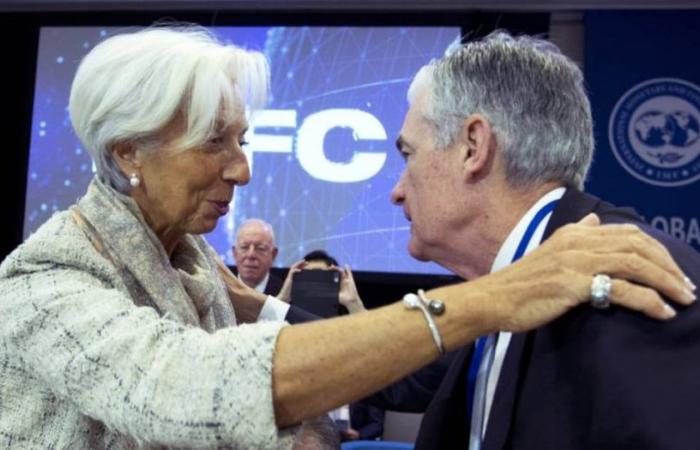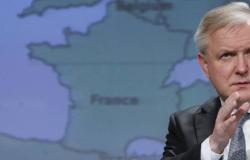We are dependent on the data, not on the Federal Reserve,” Christine Lagarde answered at the press conference after the ECB meeting in April. “At the outset, I don’t speculate on what other central banks are going to do or not do,” she snapped in the next question, which also pointed to the extent to which the Federal Reserve’s decisions would impact the ECB’s plans. This Wednesday the monetary authority changed its forecasts for the remainder of the year, delaying to 2025 two of the three rate cuts it initially expected (and one of those from 2025 to 2026). The eurozone, meanwhile, has put aside autopilot and operates match by match based on the data, although it has started lowering rates before the US.
The behavior of the debt on Wednesday, in any case, is a reflection of how investors think, not so much because of the Fed meeting but because of the US CPI data. Inflation was one tenth lower than expected and caused a drop in 10-year interest rates of up to 15 basis points in the euro zone, similar to that of the US bond itself. The ECB works based on the data, but the mental scheme of the debt operators is different, and they quote US inflation as much as that of the eurozone. Which leaves a question in the air, the same one that was asked to Lagarde in April: how much can the ECB separate itself from the Federal Reserve?
It all depends on how the currency market prices this interest rate gap. But so far no movement has been seen. The volatility of the exchange between the euro and the dollar has been rather low, despite the thunderous noise regarding interest rates. In fact, the European currency has not moved from the range of $1.06 to $1.10 so far this year. The ECB, for its part, has not modified its forecasts either: if in June 2023 it expected the euro to be trading at $1.09 in 2024 and 2025, since last December it has expected it to do so at $1.08.
Currency weakening, if money flows into higher rate areas, is a potential source of inflationary tensions. If the euro weakens, imported items (those denominated in dollars) are more expensive, causing inflation. It is the argument why monetary policies should not diverge too much. But not everyone sells items in dollars, and if the euro does not weaken (or even strengthen) against other currencies, imported inflation is mitigated. In the ECB’s forecasts, in fact, the weighted average exchange rate of the euro is stronger, not weaker, than in previous estimates.
“The disparity in economic fundamentals would justify a relevant divergence in rate differentials. The American economy has performed much more robustly and its inflation, according to our forecasts, is going to be more persistent than that of the euro zone. It is true that this could lead to higher imported inflation, in cases of extreme divergence, through the exchange rate,” indicates Rubén Segura-Cayuela, chief economist for Europe at Bank of America. The investment bank explains in a report that, in its conversations with investors, most of them find it difficult to see three cuts from the ECB and none from the Fed. “It all depends on how much the euro depreciates to threaten the convergence of the inflation at 2% at the end of 2025,” he adds. “We would need to see the euro-dollar falling to 1.02 or 1.03 for the ECB to put the risk on its path. “We think this is unlikely even if the Fed does not touch rates.”
The euro is at a high in more than three decades against the yen, and the trade war may reach the currency market
Now, one thing is the real impact of the gap between interest rates and another thing is the perceived, feared or desired impact. “If the original hypothesis of three rate cuts were to materialize and the Federal Reserve did not respond, this would undoubtedly have an impact on the exchange rate, and with it on inflation,” Robert Holzmann indicated last Saturday. Jerome Powell’s policy is currently an argument for those who believe that the ECB should not lower rates. Now, at last week’s meeting, the Austrian was the only member of the governing council to oppose the rate cut, arguing that the ECB had raised inflation forecasts.
Additionally, other currencies enter the equation, not just the dollar. The euro has been at a high against the yen since 1992, and has been anchored at seven yuan since 2014. In fact, taking into account the global decoupling in rates and the advance of protectionist policies around the world (suffice as an example the European tariff on Chinese cars), it would not be surprising if currency instability became a risk factor for the market. Some market players have already pointed out the possibility that Beijing will allow a devaluation of the yuan to stimulate the economy and, incidentally, as a political weapon. Donald Trump’s economic advisors, such as Robert Lighthizer, believe the dollar is too strong. There are too many factors, other than relative rates, impacting the currency market: Europe could end up importing deflation, not inflation.
The fundamentals of both economies, meanwhile, point more to a different pace of normalization than to a total decoupling. Gilles Moëc, chief economist at Axa Investment Managers, points out that the economic circumstances of the euro zone have nothing to do with those of the United States, so the ECB could, and should, disassociate itself from the Fed to set its own path of guys. “The Governing Council could say approximately where they would go for the remainder of the year. This would have the advantage of anchoring expectations in a European market that has to deal with volatility in the US and making clear the ECB’s ability to disassociate itself from the Fed in a lasting way.”
In fact, if the Fed does not lower rates, the relative exchange rate may not be the market’s biggest concern. “A possible scenario where the Fed does not lower rates for a long time would lead to a tightening of global financial conditions, which would generate lower domestic inflation in the eurozone. In this context, although we could see temporary stops or a slower cycle of reductions by the ECB initially, the recessionary and disinflationary forces generated would end up forcing the ECB to lower rates in an accelerated and, surely, deeper manner, since in That point would require stimulating the economy,” concludes Segura Cayuela.
Follow all the information Five days in Facebook, x and Linkedinor in our newsletter Five Day Agenda
Newsletters
Sign up to receive exclusive economic information and the financial news most relevant to you
Sign up!






